Deck 21: The Theory of Consumer Choice
Question
Question
Question
Question
Question
Question
Question
Question
Question
Question
Question
Question
Question
Question
Question
Question
Question
Question
Question
Question
Question
Question
Question
Question
Question
Question
Question
Question
Question
Question
Question
Question
Question
Question
Question
Question
Question
Question
Question
Question
Question
Question
Question
Question
Question
Question
Question
Question
Question
Question
Question
Question
Question
Question
Question
Question
Question
Question
Question
Question
Question
Question
Question
Question
Question
Question
Question

Unlock Deck
Sign up to unlock the cards in this deck!
Unlock Deck
Unlock Deck
1/67
Play
Full screen (f)
Deck 21: The Theory of Consumer Choice
1
When indifference curves are bowed inward,the marginal rate of substitution is
A)the same at all points along an indifference curve.
B)increasing as the consumer moves to the right along an indifference curve.
C)decreasing as the consumer moves to the right along an indifference curve.
D)constant.
A)the same at all points along an indifference curve.
B)increasing as the consumer moves to the right along an indifference curve.
C)decreasing as the consumer moves to the right along an indifference curve.
D)constant.
C
2
The following diagram shows one indifference curve representing the preferences for goods X and Y for one consumer. 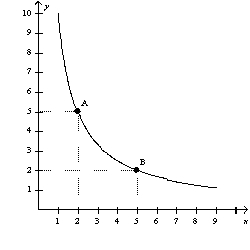 What is the marginal rate of substitution between points A and B?
What is the marginal rate of substitution between points A and B?
A)2/5
B)1
C)5/2
D)3
 What is the marginal rate of substitution between points A and B?
What is the marginal rate of substitution between points A and B?A)2/5
B)1
C)5/2
D)3
B
3
Which of the following statements is correct?
A)The theory of consumer choice provides a more complete understanding of supply,just as the theory of the competitive firm provides a more complete understanding of demand.
B)The theory of consumer choice provides a more complete understanding of demand,just as the theory of the competitive firm provides a more complete understanding of supply.
C)Monetary theory provides a more complete understanding of demand,just as the theory of the competitive firm provides a more complete understanding of supply.
D)The theory of public choice provides a more complete understanding of supply,just as the theory of the competitive firm provides a more complete understanding of demand.
A)The theory of consumer choice provides a more complete understanding of supply,just as the theory of the competitive firm provides a more complete understanding of demand.
B)The theory of consumer choice provides a more complete understanding of demand,just as the theory of the competitive firm provides a more complete understanding of supply.
C)Monetary theory provides a more complete understanding of demand,just as the theory of the competitive firm provides a more complete understanding of supply.
D)The theory of public choice provides a more complete understanding of supply,just as the theory of the competitive firm provides a more complete understanding of demand.
B
4
Figure 21-3
In each case,the budget constraint moves from BC-1 to BC-2.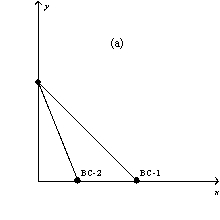

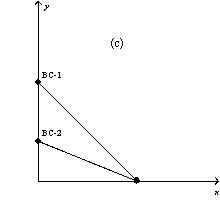
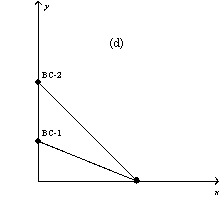
Consider two goods,books and CDs.The slope of the consumer's budget constraint is measured by the
A)consumer's income divided by the price of CDs.
B)relative price of books and CDs.
C)consumer's marginal rate of substitution.
D)number of books purchased divided by the number of CDs purchased.
In each case,the budget constraint moves from BC-1 to BC-2.




Consider two goods,books and CDs.The slope of the consumer's budget constraint is measured by the
A)consumer's income divided by the price of CDs.
B)relative price of books and CDs.
C)consumer's marginal rate of substitution.
D)number of books purchased divided by the number of CDs purchased.

Unlock Deck
Unlock for access to all 67 flashcards in this deck.
Unlock Deck
k this deck
5
Suppose Caroline is indifferent between tea and coffee as long as she consumes an equivalent amount of caffeine.Suppose that coffee has twice as much caffeine as tea.Which graph would illustrate a representative indifference curve?
A)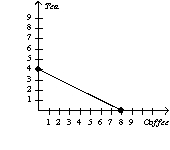
B)
C)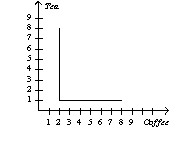
D)
A)

B)

C)

D)


Unlock Deck
Unlock for access to all 67 flashcards in this deck.
Unlock Deck
k this deck
6
Figure 21-11 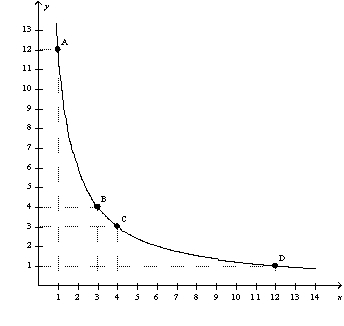
Refer to Figure 21-11.What is the consumer's marginal rate of substitution as she moves from A to B?
A)12
B)6
C)4
D)1

Refer to Figure 21-11.What is the consumer's marginal rate of substitution as she moves from A to B?
A)12
B)6
C)4
D)1

Unlock Deck
Unlock for access to all 67 flashcards in this deck.
Unlock Deck
k this deck
7
An indifference curve illustrates
A)a firm's profits.
B)a consumer's budget.
C)a consumer's preferences.
D)the prices of two goods.
A)a firm's profits.
B)a consumer's budget.
C)a consumer's preferences.
D)the prices of two goods.

Unlock Deck
Unlock for access to all 67 flashcards in this deck.
Unlock Deck
k this deck
8
Figure 21-1 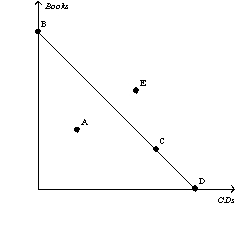
Refer to Figure 21-1.All of the points identified in the figure represent affordable consumption options with the exception of
A)A.
B)E.
C)A and E.
D)None.All points are affordable.

Refer to Figure 21-1.All of the points identified in the figure represent affordable consumption options with the exception of
A)A.
B)E.
C)A and E.
D)None.All points are affordable.

Unlock Deck
Unlock for access to all 67 flashcards in this deck.
Unlock Deck
k this deck
9
Figure 21-14 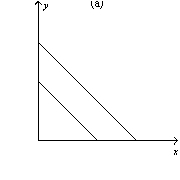
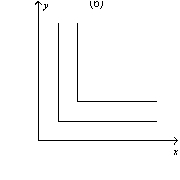
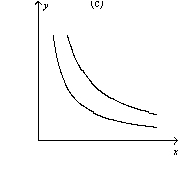
Refer to Figure 21-14.Which of the graphs shown represent indifference curves for perfect complements?
A)graph a
B)graph b
C)graph c
D)All of the above are correct.



Refer to Figure 21-14.Which of the graphs shown represent indifference curves for perfect complements?
A)graph a
B)graph b
C)graph c
D)All of the above are correct.

Unlock Deck
Unlock for access to all 67 flashcards in this deck.
Unlock Deck
k this deck
10
Figure 21-10 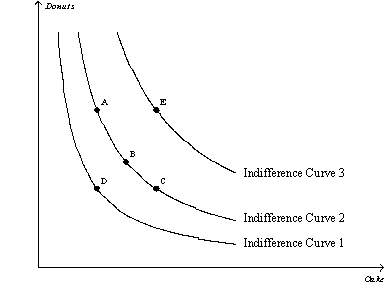
Refer to Figure 21-10.When comparing bundle A to bundle E,the consumer
A)prefers bundle A because it contains more donuts.
B)prefers bundle E because it lies on a higher indifference curve.
C)prefers bundle E because it contains more donuts.
D)is indifferent between the two bundles.

Refer to Figure 21-10.When comparing bundle A to bundle E,the consumer
A)prefers bundle A because it contains more donuts.
B)prefers bundle E because it lies on a higher indifference curve.
C)prefers bundle E because it contains more donuts.
D)is indifferent between the two bundles.

Unlock Deck
Unlock for access to all 67 flashcards in this deck.
Unlock Deck
k this deck
11
A consumer's preferences provide a ranking of
A)all possible consumption bundles.
B)only the consumption bundles that fall on the same indifference curve.
C)consumption bundles based their prices.
D)consumption bundles based on the consumer's income.
A)all possible consumption bundles.
B)only the consumption bundles that fall on the same indifference curve.
C)consumption bundles based their prices.
D)consumption bundles based on the consumer's income.

Unlock Deck
Unlock for access to all 67 flashcards in this deck.
Unlock Deck
k this deck
12
Bundle A contains 10 units of good X and 5 units of good Y.Bundle B contains 5 units of good X and 10 units of good Y.Bundle C contains 10 units of good X and 10 units of good Y.The consumer is indifferent between bundle A and bundle B.Assume that the consumer's preferences satisfy the four properties of indifference curves.Which of the following statements is correct?
A)The consumer must prefer bundle C to either bundle A or B.
B)Bundle A and bundle B lie on the same indifference curve.
C)The consumer must prefer bundle B to bundle C.
D)Both a)and b)are correct.
A)The consumer must prefer bundle C to either bundle A or B.
B)Bundle A and bundle B lie on the same indifference curve.
C)The consumer must prefer bundle B to bundle C.
D)Both a)and b)are correct.

Unlock Deck
Unlock for access to all 67 flashcards in this deck.
Unlock Deck
k this deck
13
Figure 21-17 
Refer to Figure 21-17.Bundle B represents a point where
A)MRSxy > Py/Px.
B)MRSxy = Px/Py.
C)MRSxy < Px/Py.
D)MRSxy > Px/Py.

Refer to Figure 21-17.Bundle B represents a point where
A)MRSxy > Py/Px.
B)MRSxy = Px/Py.
C)MRSxy < Px/Py.
D)MRSxy > Px/Py.

Unlock Deck
Unlock for access to all 67 flashcards in this deck.
Unlock Deck
k this deck
14
Figure 21-17 
Refer to Figure 21-17.It would be possible for the consumer to reach I2 if
A)the price of Y decreases.
B)the price of X decreases.
C)income increases.
D)All of the above would be correct.

Refer to Figure 21-17.It would be possible for the consumer to reach I2 if
A)the price of Y decreases.
B)the price of X decreases.
C)income increases.
D)All of the above would be correct.

Unlock Deck
Unlock for access to all 67 flashcards in this deck.
Unlock Deck
k this deck
15
Figure 21-11 
Refer to Figure 21-11.The graph illustrates
A)a typical budget constraint.
B)a typical indifference curve.
C)an indifference curve where goods X and Y are perfect complements.
D)an indifference curve where goods X and Y are perfect substitutes.

Refer to Figure 21-11.The graph illustrates
A)a typical budget constraint.
B)a typical indifference curve.
C)an indifference curve where goods X and Y are perfect complements.
D)an indifference curve where goods X and Y are perfect substitutes.

Unlock Deck
Unlock for access to all 67 flashcards in this deck.
Unlock Deck
k this deck
16
Figure 21-3
In each case,the budget constraint moves from BC-1 to BC-2.



An increase in income will cause a consumer's budget constraint to
A)shift outward,parallel to its initial position.
B)shift inward,parallel to its initial position.
C)pivot along the horizontal axis.
D)pivot along the vertical axis.
In each case,the budget constraint moves from BC-1 to BC-2.




An increase in income will cause a consumer's budget constraint to
A)shift outward,parallel to its initial position.
B)shift inward,parallel to its initial position.
C)pivot along the horizontal axis.
D)pivot along the vertical axis.

Unlock Deck
Unlock for access to all 67 flashcards in this deck.
Unlock Deck
k this deck
17
Figure 21-3
In each case,the budget constraint moves from BC-1 to BC-2.



If the price of bread is zero,the budget constraint between bread (on the vertical axis)and cheese (on the horizontal axis)would
A)be vertical.
B)coincide with the vertical axis.
C)coincide with the horizontal axis.
D)be horizontal.
In each case,the budget constraint moves from BC-1 to BC-2.




If the price of bread is zero,the budget constraint between bread (on the vertical axis)and cheese (on the horizontal axis)would
A)be vertical.
B)coincide with the vertical axis.
C)coincide with the horizontal axis.
D)be horizontal.

Unlock Deck
Unlock for access to all 67 flashcards in this deck.
Unlock Deck
k this deck
18
Figure 21-10 
Refer to Figure 21-10.Which of the following statements is correct?
A)Bundle A provides the same utility as bundle E.
B)Bundle A provides the same utility as bundle C.
C)Bundle B contains more cake than bundle C.
D)The bundles along indifference curve Indifference Curve 2 are preferred to those along indifference curve Indifference Curve 3.

Refer to Figure 21-10.Which of the following statements is correct?
A)Bundle A provides the same utility as bundle E.
B)Bundle A provides the same utility as bundle C.
C)Bundle B contains more cake than bundle C.
D)The bundles along indifference curve Indifference Curve 2 are preferred to those along indifference curve Indifference Curve 3.

Unlock Deck
Unlock for access to all 67 flashcards in this deck.
Unlock Deck
k this deck
19
Figure 21-3
In each case,the budget constraint moves from BC-1 to BC-2.



A budget constraint shows
A)the maximum utility that a consumer can achieve for a given level of income.
B)a series of bundles that cost the consumer the same amount of money.
C)a series of bundles that give the consumer the same level of utility.
D)All of the above are correct.
In each case,the budget constraint moves from BC-1 to BC-2.




A budget constraint shows
A)the maximum utility that a consumer can achieve for a given level of income.
B)a series of bundles that cost the consumer the same amount of money.
C)a series of bundles that give the consumer the same level of utility.
D)All of the above are correct.

Unlock Deck
Unlock for access to all 67 flashcards in this deck.
Unlock Deck
k this deck
20
When two goods are perfect substitutes,the marginal rate of substitution
A)is constant along the indifference curve.
B)decreases as the scarcity of one good increases.
C)increases as the scarcity of one good increases.
D)changes to reflect the consumer's changing preferences for the goods.
A)is constant along the indifference curve.
B)decreases as the scarcity of one good increases.
C)increases as the scarcity of one good increases.
D)changes to reflect the consumer's changing preferences for the goods.

Unlock Deck
Unlock for access to all 67 flashcards in this deck.
Unlock Deck
k this deck
21
A good is an inferior good if the consumer buys less of it when
A)his income rises.
B)the price of the good rises.
C)the price of a substitute good falls.
D)his income falls.
A)his income rises.
B)the price of the good rises.
C)the price of a substitute good falls.
D)his income falls.

Unlock Deck
Unlock for access to all 67 flashcards in this deck.
Unlock Deck
k this deck
22
Pete consumes two goods,rice and fish.When the price of fish rises,he consumes less fish.When the price of rice rises,he consumes more rice.For Pete,
A)fish is not a Giffen good but rice is.
B)rice is not a Giffen good but fish is.
C)both fish and rice are normal goods.
D)both fish and rice are Giffen goods.
A)fish is not a Giffen good but rice is.
B)rice is not a Giffen good but fish is.
C)both fish and rice are normal goods.
D)both fish and rice are Giffen goods.

Unlock Deck
Unlock for access to all 67 flashcards in this deck.
Unlock Deck
k this deck
23
The goal of the consumer is to
A)maximize utility.
B)be on the highest indifference curve.
C)maximize satisfaction.
D)All of the above are the goals of the consumer.
A)maximize utility.
B)be on the highest indifference curve.
C)maximize satisfaction.
D)All of the above are the goals of the consumer.

Unlock Deck
Unlock for access to all 67 flashcards in this deck.
Unlock Deck
k this deck
24
A consumer has preferences over two goods,X and Y.Suppose we graph this consumer's preferences (which satisfy the usual properties of indifference curves)and budget constraint on a diagram with X on the horizontal axis and Y on the vertical axis.At the consumer's current consumption bundle,the consumer is spending all available income,and the marginal rate of substitution is greater than the slope of the budget constraint.We can conclude that the consumer
A)is currently maximizing satisfaction subject to the budget constraint.
B)could increase satisfaction by consuming more X and less Y.
C)could increase satisfaction by consuming less X and more Y.
D)could purchase more X and more Y and increase total satisfaction.
A)is currently maximizing satisfaction subject to the budget constraint.
B)could increase satisfaction by consuming more X and less Y.
C)could increase satisfaction by consuming less X and more Y.
D)could purchase more X and more Y and increase total satisfaction.

Unlock Deck
Unlock for access to all 67 flashcards in this deck.
Unlock Deck
k this deck
25
Dave consumes two normal goods,X and Y,and is currently at an optimum.If the price of good X falls,we can predict with certainty that
A)Dave will consume more of both goods because his real income has risen.
B)the substitution effect will be positive for good X and negative for good Y.
C)Dave may consume more or less of good X,but he will consume less of good Y.
D)the substitution effect will offset the income effect for good X.
A)Dave will consume more of both goods because his real income has risen.
B)the substitution effect will be positive for good X and negative for good Y.
C)Dave may consume more or less of good X,but he will consume less of good Y.
D)the substitution effect will offset the income effect for good X.

Unlock Deck
Unlock for access to all 67 flashcards in this deck.
Unlock Deck
k this deck
26
When economists describe preferences,they often use the concept of
A)markets.
B)income.
C)utility.
D)prices.
A)markets.
B)income.
C)utility.
D)prices.

Unlock Deck
Unlock for access to all 67 flashcards in this deck.
Unlock Deck
k this deck
27
Good X is a Giffen good.When the price of X increases,the consumer will consume
A)more X.
B)the same amount of X.
C)less X.
D)more or less X depending on the size of the income effect relative to the size of the substitution effect.
A)more X.
B)the same amount of X.
C)less X.
D)more or less X depending on the size of the income effect relative to the size of the substitution effect.

Unlock Deck
Unlock for access to all 67 flashcards in this deck.
Unlock Deck
k this deck
28
A Giffen good is a good for which
A)an increase in the price raises the quantity demanded.
B)the income effect outweighs the substitution effect.
C)an increase in the price decreases the quantity demanded.
D)Both a)and b)are correct.
A)an increase in the price raises the quantity demanded.
B)the income effect outweighs the substitution effect.
C)an increase in the price decreases the quantity demanded.
D)Both a)and b)are correct.

Unlock Deck
Unlock for access to all 67 flashcards in this deck.
Unlock Deck
k this deck
29
A consumer chooses an optimal consumption point where the
A)marginal rate of substitution exceeds the relative price ratio.
B)slope of the indifference curve equals the slope of the budget constraint.
C)ratio of the prices equals one.
D)All of the above are correct.
A)marginal rate of substitution exceeds the relative price ratio.
B)slope of the indifference curve equals the slope of the budget constraint.
C)ratio of the prices equals one.
D)All of the above are correct.

Unlock Deck
Unlock for access to all 67 flashcards in this deck.
Unlock Deck
k this deck
30
We can use the theory of consumer choice to analyze
A)why most demand curves slope downward.
B)the tradeoff between work and leisure
C)how interest rates affect household saving.
D)All of the above are correct.
A)why most demand curves slope downward.
B)the tradeoff between work and leisure
C)how interest rates affect household saving.
D)All of the above are correct.

Unlock Deck
Unlock for access to all 67 flashcards in this deck.
Unlock Deck
k this deck
31
Figure 21-17 
Refer to Figure 21-17.Bundle D represents a point where
A)MRSxy > Py/Px.
B)MRSxy = Px/Py.
C)MRSxy < Px/Py.
D)MRSxy < Py/Px.

Refer to Figure 21-17.Bundle D represents a point where
A)MRSxy > Py/Px.
B)MRSxy = Px/Py.
C)MRSxy < Px/Py.
D)MRSxy < Py/Px.

Unlock Deck
Unlock for access to all 67 flashcards in this deck.
Unlock Deck
k this deck
32
The substitution effect from an increase in wages is evident in a
A)decrease in labor demand.
B)desire to consume less leisure.
C)desire to consume more leisure.
D)backward-bending labor supply curve.
A)decrease in labor demand.
B)desire to consume less leisure.
C)desire to consume more leisure.
D)backward-bending labor supply curve.

Unlock Deck
Unlock for access to all 67 flashcards in this deck.
Unlock Deck
k this deck
33
Kristi spends all of her income on tank tops and running shoes,and the price of a pair of running shoes is four times the price of a tank top.In order to maximize total utility,Kristi should buy
A)four times as many tank tops as pairs of running shoes.
B)four times as many pairs of running shoes as tank tops.
C)both items until the marginal utility of a pair of running shoes is four times the marginal utility of a tank top.
D)both items until the marginal utility of a tank top is four times the marginal utility of a pair of running shoes.
A)four times as many tank tops as pairs of running shoes.
B)four times as many pairs of running shoes as tank tops.
C)both items until the marginal utility of a pair of running shoes is four times the marginal utility of a tank top.
D)both items until the marginal utility of a tank top is four times the marginal utility of a pair of running shoes.

Unlock Deck
Unlock for access to all 67 flashcards in this deck.
Unlock Deck
k this deck
34
Which of the following equations corresponds to an optimal choice point?
(i)MRS = PX/PY
(ii)MUX/MUY = PX/PY
(iii)MUX/PX = MUY/PY
(iv)MUX/PY = MUY/PX
A)(i)only
B)(i),(ii),and (iii)only
C)(ii)and (iv)only
D)(i),(ii),(iii),and (iv)
(i)MRS = PX/PY
(ii)MUX/MUY = PX/PY
(iii)MUX/PX = MUY/PY
(iv)MUX/PY = MUY/PX
A)(i)only
B)(i),(ii),and (iii)only
C)(ii)and (iv)only
D)(i),(ii),(iii),and (iv)

Unlock Deck
Unlock for access to all 67 flashcards in this deck.
Unlock Deck
k this deck
35
Consider the indifference curve map and budget constraint for two goods,X and Y.Suppose the good on the horizontal axis,X,is normal.When the price of X increases,the substitution effect
A)and income effect both cause an increase in the consumption of X.
B)causes a decrease in the consumption of X,and the income effect causes an increase in the consumption of X.However,the substitution effect is greater than the income effect.
C)causes an increase in the consumption of X,and the income effect causes a decrease in the consumption of X.However,the substitution effect is greater than the income effect.
D)and income effect both cause a decrease in the consumption of X.
A)and income effect both cause an increase in the consumption of X.
B)causes a decrease in the consumption of X,and the income effect causes an increase in the consumption of X.However,the substitution effect is greater than the income effect.
C)causes an increase in the consumption of X,and the income effect causes a decrease in the consumption of X.However,the substitution effect is greater than the income effect.
D)and income effect both cause a decrease in the consumption of X.

Unlock Deck
Unlock for access to all 67 flashcards in this deck.
Unlock Deck
k this deck
36
Utility measures the
A)income a consumer receives from consuming a bundle of goods.
B)satisfaction a consumer receives from consuming a bundle of goods.
C)satisfaction a consumer places on her budget constraint.
D)All of the above are correct.
A)income a consumer receives from consuming a bundle of goods.
B)satisfaction a consumer receives from consuming a bundle of goods.
C)satisfaction a consumer places on her budget constraint.
D)All of the above are correct.

Unlock Deck
Unlock for access to all 67 flashcards in this deck.
Unlock Deck
k this deck
37
If income decreases and prices are unchanged,the consumer's budget constraint
A)remains the same.
B)shifts outward.
C)shifts inward.
D)rotates outward along the horizontal axis.
A)remains the same.
B)shifts outward.
C)shifts inward.
D)rotates outward along the horizontal axis.

Unlock Deck
Unlock for access to all 67 flashcards in this deck.
Unlock Deck
k this deck
38
If we observe that a consumer's budget constraint has shifted inward,we can assume that the consumer will buy
A)fewer normal goods and more inferior goods.
B)more normal goods and fewer inferior goods.
C)more normal goods and more inferior goods.
D)fewer normal goods and fewer inferior goods.
A)fewer normal goods and more inferior goods.
B)more normal goods and fewer inferior goods.
C)more normal goods and more inferior goods.
D)fewer normal goods and fewer inferior goods.

Unlock Deck
Unlock for access to all 67 flashcards in this deck.
Unlock Deck
k this deck
39
Consider the indifference curve map and budget constraint for two goods,beef and potatoes.Suppose the good measured on the horizontal axis,potatoes,is a Giffen good.Beef is measured on the vertical axis and is a normal good.When the price of potatoes increases,the substitution effect causes
A)an increase in the consumption of potatoes,and the income effect causes a decrease in the consumption of potatoes.The substitution effect is less than the income effect.
B)a decrease in the consumption of potatoes,and the income effect causes an increase in the consumption of potatoes.The substitution effect is greater than the income effect.
C)an increase in the consumption of potatoes,and the income effect causes a decrease in the consumption of potatoes.The substitution effect is greater than the income effect.
D)a decrease in the consumption of potatoes,and the income effect causes an increase in the consumption of potatoes.The substitution effect is less than the income effect.
A)an increase in the consumption of potatoes,and the income effect causes a decrease in the consumption of potatoes.The substitution effect is less than the income effect.
B)a decrease in the consumption of potatoes,and the income effect causes an increase in the consumption of potatoes.The substitution effect is greater than the income effect.
C)an increase in the consumption of potatoes,and the income effect causes a decrease in the consumption of potatoes.The substitution effect is greater than the income effect.
D)a decrease in the consumption of potatoes,and the income effect causes an increase in the consumption of potatoes.The substitution effect is less than the income effect.

Unlock Deck
Unlock for access to all 67 flashcards in this deck.
Unlock Deck
k this deck
40
An optimizing consumer will select the consumption bundle in which the
A)ratio of total utilities is equal to the relative price ratio.
B)ratio of income to price equals the marginal rate of substitution.
C)marginal rate of substitution is equal to the relative price ratio of the goods.
D)marginal rate of substitution is equal to marginal utility.
A)ratio of total utilities is equal to the relative price ratio.
B)ratio of income to price equals the marginal rate of substitution.
C)marginal rate of substitution is equal to the relative price ratio of the goods.
D)marginal rate of substitution is equal to marginal utility.

Unlock Deck
Unlock for access to all 67 flashcards in this deck.
Unlock Deck
k this deck
41
The opportunity cost of current household consumption is the
A)wage rate.
B)market interest rate.
C)price of the goods consumed.
D)explicit cost of consumption.
A)wage rate.
B)market interest rate.
C)price of the goods consumed.
D)explicit cost of consumption.

Unlock Deck
Unlock for access to all 67 flashcards in this deck.
Unlock Deck
k this deck
42
The direction of the substitution effect is not influenced by whether the good is normal or inferior.

Unlock Deck
Unlock for access to all 67 flashcards in this deck.
Unlock Deck
k this deck
43
If a consumer purchases more of good X and good Y after her income increases,then neither good X nor good Y is an inferior good for her.

Unlock Deck
Unlock for access to all 67 flashcards in this deck.
Unlock Deck
k this deck
44
If goods A and B are perfect substitutes,then the marginal rate of substitution of good A for good B is constant.

Unlock Deck
Unlock for access to all 67 flashcards in this deck.
Unlock Deck
k this deck
45
Assume that consumption when young and consumption when old are both normal goods.The income effect of an increase in the interest rate will result in
A)an increase in saving when young.
B)an increase in saving when old.
C)a decrease in saving when young.
D)a decrease in saving when old.
A)an increase in saving when young.
B)an increase in saving when old.
C)a decrease in saving when young.
D)a decrease in saving when old.

Unlock Deck
Unlock for access to all 67 flashcards in this deck.
Unlock Deck
k this deck
46
If an increase in the interest rate raises savings,then
A)the substitution effect is greater than the income effect.
B)the income effect is greater than the substitution effect.
C)the income effect and the substitution effect move in the same direction.
D)we are unable to determine the sizes of the income and substitution effects without more information.
A)the substitution effect is greater than the income effect.
B)the income effect is greater than the substitution effect.
C)the income effect and the substitution effect move in the same direction.
D)we are unable to determine the sizes of the income and substitution effects without more information.

Unlock Deck
Unlock for access to all 67 flashcards in this deck.
Unlock Deck
k this deck
47
A budget constraint illustrates bundles that a consumer prefers equally,while an indifference curve illustrates bundles that are equally affordable to a consumer.

Unlock Deck
Unlock for access to all 67 flashcards in this deck.
Unlock Deck
k this deck
48
Giffen goods violate the law of demand.

Unlock Deck
Unlock for access to all 67 flashcards in this deck.
Unlock Deck
k this deck
49
A consumer's optimal choice is affected by income,prices of goods,and preferences.

Unlock Deck
Unlock for access to all 67 flashcards in this deck.
Unlock Deck
k this deck
50
The slope of a consumer's budget constraint is unaffected by a change in income.

Unlock Deck
Unlock for access to all 67 flashcards in this deck.
Unlock Deck
k this deck
51
The theory of consumer choice provides a(n)
A)literal account of how people make decisions.
B)unrealistic picture of how people make decisions.
C)model that is consistent with how people make decisions.
D)in-depth model that is based more in psychology than in economics.
A)literal account of how people make decisions.
B)unrealistic picture of how people make decisions.
C)model that is consistent with how people make decisions.
D)in-depth model that is based more in psychology than in economics.

Unlock Deck
Unlock for access to all 67 flashcards in this deck.
Unlock Deck
k this deck
52
The marginal rate of substitution is the slope of the indifference curve.

Unlock Deck
Unlock for access to all 67 flashcards in this deck.
Unlock Deck
k this deck
53
The theory of consumer choice illustrates that people face tradeoffs,which is one of the Ten Principles of Economics.

Unlock Deck
Unlock for access to all 67 flashcards in this deck.
Unlock Deck
k this deck
54
The income effect of a price change is the change in consumption that results from the movement to a new indifference curve.

Unlock Deck
Unlock for access to all 67 flashcards in this deck.
Unlock Deck
k this deck
55
Economists have found evidence of a Giffen good when studying the consumption of rice in the Chinese province of Hunan.

Unlock Deck
Unlock for access to all 67 flashcards in this deck.
Unlock Deck
k this deck
56
If a consumer purchases more of good B when his income rises,good B is an inferior good.

Unlock Deck
Unlock for access to all 67 flashcards in this deck.
Unlock Deck
k this deck
57
A consumer's budget constraint for goods X and Y is determined by how much the consumer likes good X relative to good Y.

Unlock Deck
Unlock for access to all 67 flashcards in this deck.
Unlock Deck
k this deck
58
If the interest rate rises,an individual could choose to
A)increase consumption when young.
B)increase consumption when old.
C)decrease consumption when young.
D)Any of the above could be correct.
A)increase consumption when young.
B)increase consumption when old.
C)decrease consumption when young.
D)Any of the above could be correct.

Unlock Deck
Unlock for access to all 67 flashcards in this deck.
Unlock Deck
k this deck
59
The substitution effect in the work-leisure model induces a person to work less in response to higher wages,which tends to make the labor-supply curve slope upward.

Unlock Deck
Unlock for access to all 67 flashcards in this deck.
Unlock Deck
k this deck
60
For a typical consumer,most indifference curves are bowed inward.

Unlock Deck
Unlock for access to all 67 flashcards in this deck.
Unlock Deck
k this deck
61
Explain the relationship between the budget constraint and indifference curve at a consumer's optimum.

Unlock Deck
Unlock for access to all 67 flashcards in this deck.
Unlock Deck
k this deck
62
A rise in the interest rate will generally result in people consuming less when they are old if the substitution effect outweighs the income effect.

Unlock Deck
Unlock for access to all 67 flashcards in this deck.
Unlock Deck
k this deck
63
Graphically demonstrate the conditions associated with a consumer optimum.Carefully label all curves and axes.

Unlock Deck
Unlock for access to all 67 flashcards in this deck.
Unlock Deck
k this deck
64
Using indifference curves and budget constraints,graphically illustrate the substitution and income effect that would result from a change in the price of a normal good.

Unlock Deck
Unlock for access to all 67 flashcards in this deck.
Unlock Deck
k this deck
65
Evaluate the following statement,"Warren Buffet is the second richest person in the world.He doesn't face any constraint on his ability to purchase commodities he wants."

Unlock Deck
Unlock for access to all 67 flashcards in this deck.
Unlock Deck
k this deck
66
Draw a budget constraint that is consistent with the following prices and income.
Income = 200
PY = 50
PX = 25
a.Demonstrate how your original budget constraint would change if income increases to 500.
b.Demonstrate how your original budget constraint would change if PY decreases to 20.
c.Demonstrate how your original budget constraint would change if PX increases to 40.
Income = 200
PY = 50
PX = 25
a.Demonstrate how your original budget constraint would change if income increases to 500.
b.Demonstrate how your original budget constraint would change if PY decreases to 20.
c.Demonstrate how your original budget constraint would change if PX increases to 40.

Unlock Deck
Unlock for access to all 67 flashcards in this deck.
Unlock Deck
k this deck
67
List and briefly explain each of the four properties of indifference curves.

Unlock Deck
Unlock for access to all 67 flashcards in this deck.
Unlock Deck
k this deck



